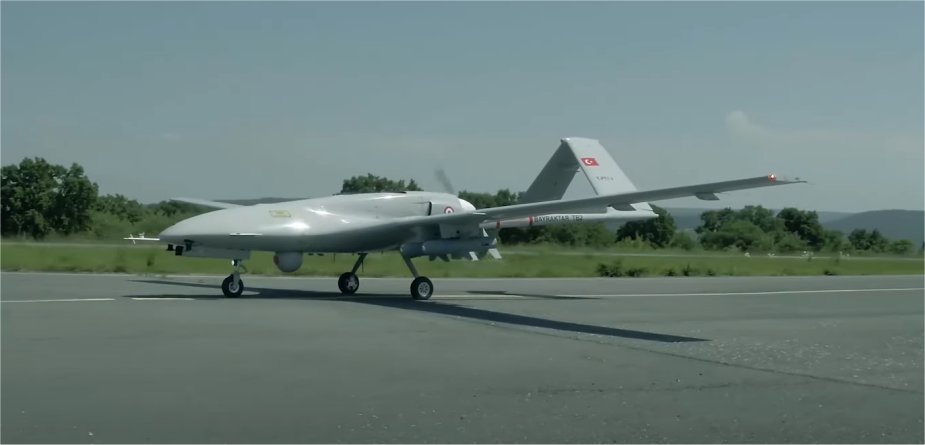Breaking news
Baykar starts building Bayraktar drone factory in Ukraine.
According to an article published by Al Arabiya on July 10, 2023, the Turkish defense company Baykar has begun the construction of a factory in Ukraine to produce Bayraktar drones, as announced by Ukraine's Minister for Strategic Industries, Oleksandr Kamyshin. This move comes as a result of a previously negotiated agreement between Türkiye and Ukraine.
Follow Air Recognition on Google News at this link
 A Bayraktar TB2 drone (Picture source: Baykar Technologies)
A Bayraktar TB2 drone (Picture source: Baykar Technologies)
The decision to establish the manufacturing plant in Ukraine stems from the effective utilization of Bayraktar drones against Russian forces during the initial weeks of the 2022 Russian invasion. The drones played a role in countering Russian armor and anti-aircraft systems, gaining recognition for their performance. Baykar's CEO announced the construction plans in October 2022, setting a two-year timeframe for completion.
The factory will manufacture drones equipped with Ukrainian-made engines, and it will also include a training center for Ukrainian pilots. This development reflects the commitment of both countries to enhance their defense capabilities through the production and utilization of advanced combat drones.
The construction of the manufacturing plant in Ukraine marks an important step in Baykar's drone operations. The production of Bayraktar drones on Ukrainian soil aims to enhance both Türkiye and Ukraine's defense capabilities and strengthen their strategic partnership in response to evolving security challenges.
The Bayraktar TB2 is a well-known Turkish combat drone recognized for its operational effectiveness, which has been extensively deployed in various military operations worldwide. The drone has been utilized in various regions, including Ukraine, Syria, and Libya. Furthermore, Baykar has already secured export agreements with 30 countries for the Bayraktar TB2, including Qatar and Azerbaijan, for their own military operations.
The TB2 is a medium-altitude, long-endurance unmanned aerial vehicle (UAV) equipped with advanced technologies such as high-resolution cameras, thermal sensors, and laser-guided munitions. Its extended flight endurance and real-time intelligence capabilities provide valuable support for surveillance, reconnaissance, and target acquisition for ground forces. The utilization of combat drones like the Bayraktar TB2 underscores their significance in modern warfare.
The TB2 unmanned aerial vehicle (UAV) is operated remotely by a ground control station with a crew of three. It has a length of 6.5 meters (21 feet 4 inches), a wingspan of 12 meters (39 feet 4 inches), and a maximum take-off mass of 700 kg (1,540 lbs).
With a payload capacity of 150 kg (331 lbs), this UAV is powered by a 100 hp (75 kW) Rotax 912-iS internal combustion engine and uses a 2-bladed variable-pitch propeller. Its fuel capacity is 300 liters (79 US gallons), and it runs on gasoline.
In terms of performance, the TB2 can reach a maximum speed of 120 knots (222 km/h) and cruise at 70 knots (130 km/h). It has an impressive range of up to 4,000 km (2,160 nautical miles) and a communication range of less than 300 km (186 miles) due to line-of-sight propagation.
The UAV's service ceiling is 25,000 feet (7,620 meters), and it can operate at an altitude of 18,000 feet (5,486 meters) with an endurance of 27 hours.
The TB2 is equipped with various armaments, such as the Smart Micro Munition (MAM-L) and MAM-C high explosive variants. Its four hardpoints can carry combinations of MAM-C and MAM-L laser-guided smart bombs, L-UMTAS (Long Range Anti-tank Missile System), Roketsan Cirit (70 mm Missile System), TUBITAK-SAGE BOZOK Laser Guided Rockets, TUBITAK-SAGE TOGAN quad rack of GPS/INS guided 81 mm mortars, and a proposed Advanced Precision Kill Weapon System – 70mm laser-guided rocket.
For avionics, the TB2 features interchangeable EO/IR/LD imaging and targeting sensor systems or Multi Mode AESA Radar, with options such as the Aselsan CATS EO/IR/LD imaging and targeting sensor, Hensoldt ARGOS-II HDT, and Wescam MX-15D EO/IR/LD imaging and targeting sensor. The UAV also includes a Garmin GNC 255A navigation/communication transceiver for added functionality.






















